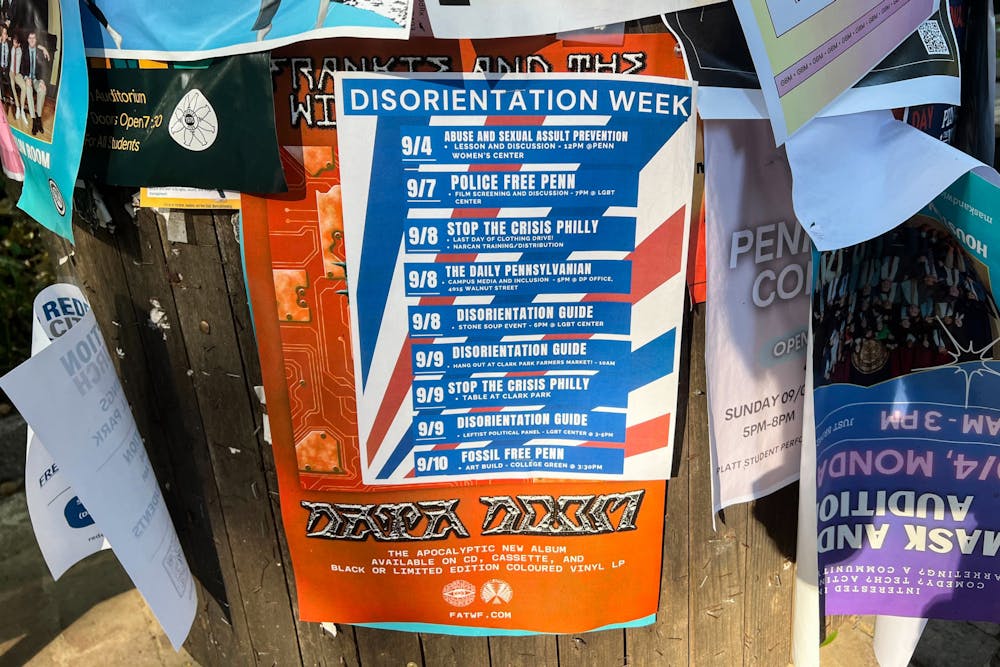In addition to publishing its annual publication, Penn Disorientation Guide hosted its first Disorientation Week this year.
The week — which ran from Sept. 4 to Sept. 9 — featured collaborative events between the Disorientation Guide and other on-campus and Philadelphia-based organizations, such as a clothing drive with Stop the Crisis Philly, a screening of “Beyond Walls” with Police Free Penn, and a community art build and zine workshop with Fossil Free Penn. The events followed the release of the annual publication on Aug. 28, which criticized Penn’s relationship with and treatment of its students, staff, and the surrounding Philadelphia community.
The Daily Pennsylvanian hosted an open house event for marginalized students to learn more about the history of the University and the independent student media company on Sept. 8 as a part of Disorientation Week.
This year’s issue is categorized into three parts, beginning with Penn's impact on students and staff, the University's impact on Philadelphia and the broader world, and a resource section for current members of the Penn community. Topics discussed include sexual violence at Penn and Penn's involvement with Philadelphia public schools.
College senior Katie Francis, an editor of this year’s Disorientation Guide, said that the publication’s goal is to publicize “everything the University of Pennsylvania doesn’t want you to know.”
“The [Disorientation Guide] serves a really important purpose to introduce people to what’s actually going on and not just the pretty picture that the University wants to paint of itself,” they said. “[Penn] is a business and it wants your money, so of course they’re not going to tell you about the harms that they commit.”
College senior and Disorientation Guide editor Mira Sydow echoed Francis’ sentiment and added that the publication “chronicles the history of activism on Penn’s campus.”
The Disorientation Guide’s earliest edition dates back to 1972, although it did not exist as an annual publication until it was brought back in 2017.
White nationalist scheduled to speak at Penn Carey Law class taught by Amy Wax
Penn must provide immediate support to sexual assault survivors
AAUP-Penn calls on admin to remove anti-union websites in support of RA, graduate student efforts
One of the Disorientation Guide’s core missions, as Sydow — a former 34th Street staffer — said, is to make students aware of the resources available to them.
“There are a lot of resources available at Penn. Some of them are offered by the University, some are offered by student groups, and some are based in Philadelphia," Sydow said. “We’re essentially parsing through and filtering all those resources for [students] to be able to access [them].”
Some of the resources offered by the Disorientation Guide include mental health hotlines, resources for FGLI and LGBTQ students, and alternatives to police services, according to Sydow.
Sydow also spoke of the Disorientation Guide’s mission to provide a safe space for minority students.
“It’s still difficult to be a gender minority or religious minority, [or] person of color on campus, and hopefully some of our writing shows people that they’re not alone in that experience,” she said.
Francis, who initially became involved with the Disorientation Guide following their involvement in Fossil Free Penn, told the DP about the interconnectedness of radical activist groups on campus.
The Disorientation Guide’s contributors span undergraduates, graduate students, professors, and community members. Campus and community groups that wrote articles in this year’s issue include Penn’s chapter of the American Association of University Professors, Graduate Employees Together – University of Pennsylvania, Penn for PILOTs, and Coalition to Save the UC Townhomes.
Francis highlighted that while the content of the Disorientation Guide can feel very demoralizing, it is important to focus on the hopeful side of activism.
“The purpose is to expose these harms so we can actually do something about them,” they said.









